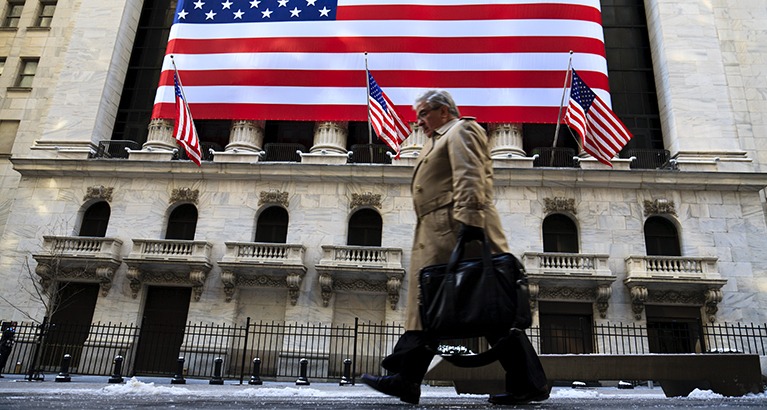The UK financial community has been engaged in huge angst in recent years over the loss of lucrative initial public offerings (IPOs) from the London Stock Exchange to the New York and Nasdaq stock exchanges in the US, including last year’s Nasdaq-listed IPO of chip designer ARM that valued the company at $54 billion.
Yet a historical market analysis published Wednesday (28 February) showed that Britain is hardly the only country to lose stock market share to the US over the past decade and more – as the US has also gained share over Japan, Canada, Germany, Switzerland, Australia and several other countries.
How US equity share has surged to 60.5% from 41% since 2010

The UBS Investment Returns Yearbook 2024 showed that the US share of world equity markets was 60.5%, up from 41% in the 2010 edition of the Yearbook and 58.4% in 2023 (when the report was called the Credit Suisse Investment Returns Yearbook, prior to last year’s UBS takeover of Credit Suisse).
The Yearbook is co-authored by Professor Elroy Dimson of Cambridge Judge Business School, Professor Paul Marsh of London Business School and Dr Mike Staunton of London Business School.
“Organised trading in marketable securities began in Amsterdam in 1602 and London in 1698 but did not commence in New York until 1792,” says the 2024 Yearbook.
“Since then, the US share of the global stock market has risen from zero to 60.5%. This reflects the superior performance of the US economy, the large volume of IPOs, and the substantial returns from US stocks. No other market can rival this long-term accomplishment.”
A comparison of 2010 with 2024 shows that part of the US increase to 60.5% from 41% reflected a 5 percentage point decline in the UK’s global equity share during this period from 8.7% in 2010 to 3.7% in 2024.
Yet more of the US gains over that period reflect an adding up of smaller gains from other countries, including: Japan (from 7.9% in 2010 to 6.2% in 2024), France (4.7% to 2.8%), Germany (3.3% to 2.1%), Canada (3.6% to 2.5%), Australia (3.5% to 2.0%), Switzerland (3.1% to 2.4%), and various other smaller countries (a total of 20% to 10%).
UBS Investment Returns Yearbook 2024 focuses on corporate bonds amid quest for higher yields
The Yearbook looks at all main asset categories in 35 markets around the world, and outlines the long-term evolution of equity markets. Since 1900, equities have outperformed bonds, bills and inflation in all 21 markets for which the Yearbook has a continuous history. Equities have dominated bonds, while bonds have outperformed treasury bills. The same held true for the rest of the 35 Yearbook markets with start dates after 1900.
The 2024 Yearbook is the 25th or Silver Jubilee edition of the publication (called The Millennium Book when it first appeared in 2000), and this year’s edition has a particular focus on corporate bonds.
At a time that investors are hunting for higher yield following a period of low returns, the Yearbook shows that over the long run US and UK investment grade corporate bonds have offered a credit premium over long-run government bonds of around 1% per year, and the credit premium from high-yield (or junk) bonds is 2% higher per year.
“Corporate bonds are a major asset class with an outstanding value of some $33 trillion, almost half that of the value of global equities and almost two-thirds that of sovereign bonds,” the Yearbook says.
The findings of a long-run credit premium is based on evidence from 1900 for the US and 1860 for the UK.
Insights on Eurozone debt trends and what makes corporate bonds distinctive
The credit premium findings are particularly timely given the current hunt for yield among investors around the world. In recent months investors have been buying the debt of heavily indebted eurozone countries such as Italy, Greece and Portugal as the gap between their borrowing cost and that of Germany has narrowed.
The authors also examine whether the credit risk for corporate bonds is distinct from the equity risk premium and the bond maturity premium, and conclude that “corporate bonds are very much a separate asset class and cannot be replicated by a combination of government bonds and equities.”
Analysing bond default and losses to provide long-term investor guidance
The Yearbook also looks at bond default and losses, highlighting the distinction.
“Corporate bonds trade on higher yields than equivalent government bonds. However, because of losses from default, the yield spread is not a measure of the extra return investors can expect. The average US default rate since 1865 has been 1.5%.
“However, in almost all cases of default, there is some recovery of value. What matters, therefore, is the loss rate, which over the last 40 years has been around 1%. For high yield bonds it was 2.7% while for investment grade bonds, it was just 0.2%.”
The Yearbook makes clear that it is not forecasting short-term returns in bonds or other asset classes, as its “purpose is instead to inform investors about long-run past performance and to allow them to draw lessons for the present”.
The Yearbook also looks at concentration of stock markets in different countries. While there has been a lot of attention focused on the size of a few big US technology companies, the report finds that the US is one of the least concentrated equity markets – with only Japan being less concentrated. The Yearbook says, for example, that in the US the 10 largest stocks account for 25% of the equity market, and this compares to 36% in the UK, 55% in France, 57% in Germany and 60% in South Korea.
Featured faculty
Elroy Dimson
Professor of Finance
Chairman of the Centre for Endowment Asset Management (CEAM)
Featured research
Dimson, E., Marsh, P. and Staunton, M. (2024) Global investment returns yearbook 2024. Zürich: UBS





